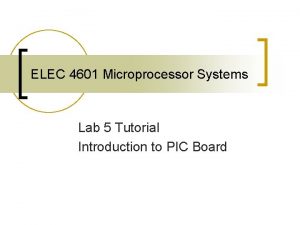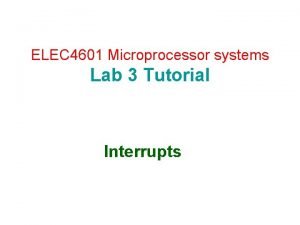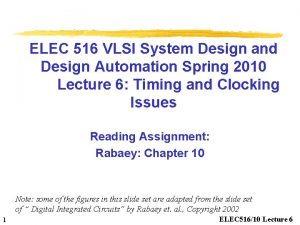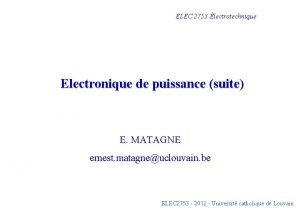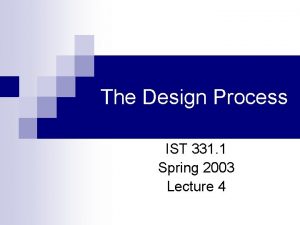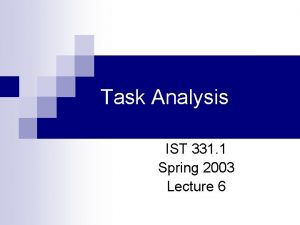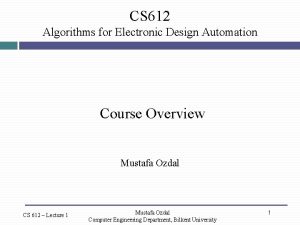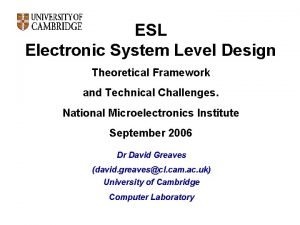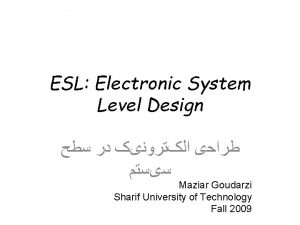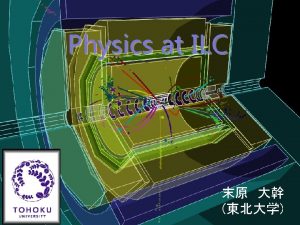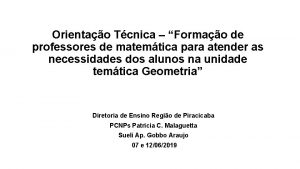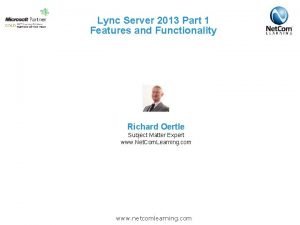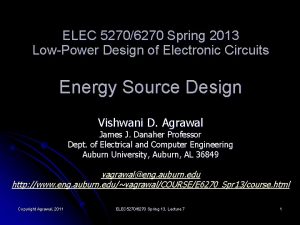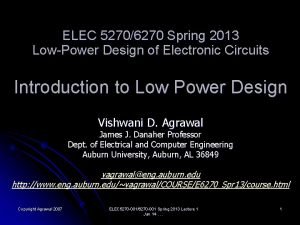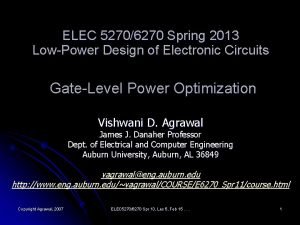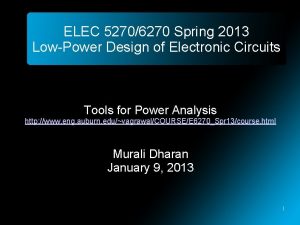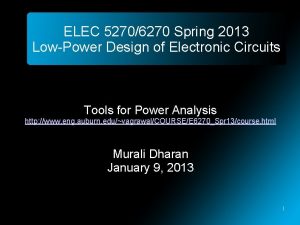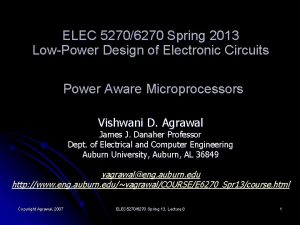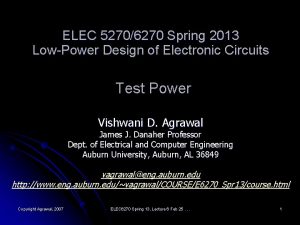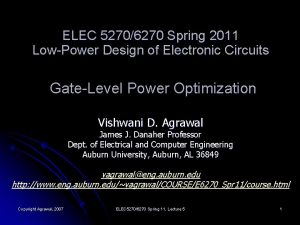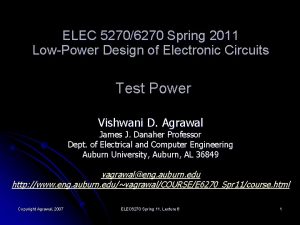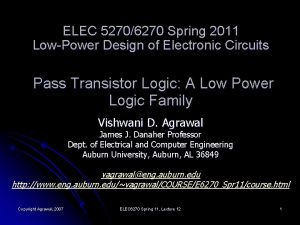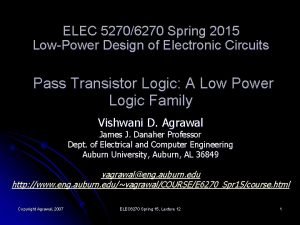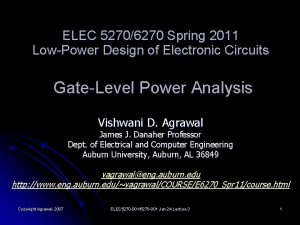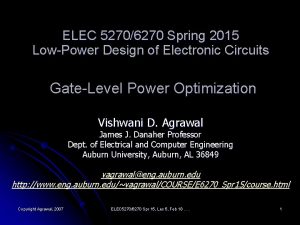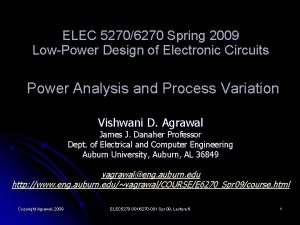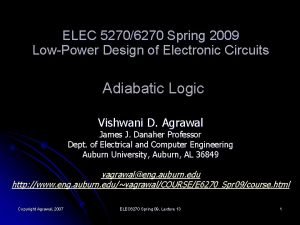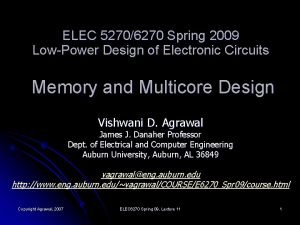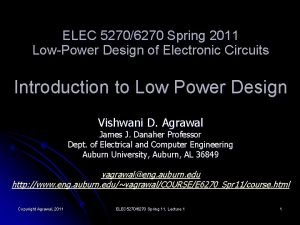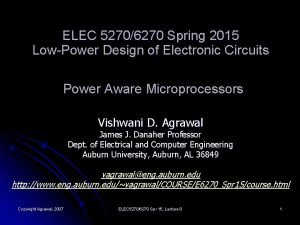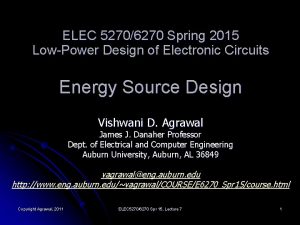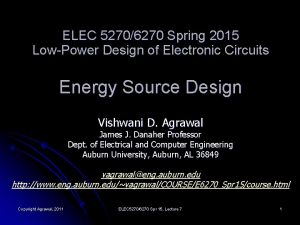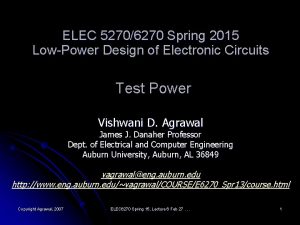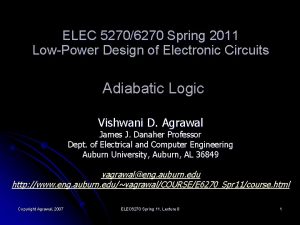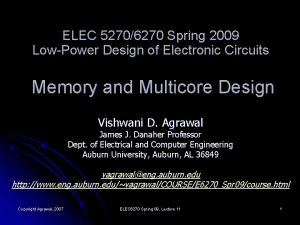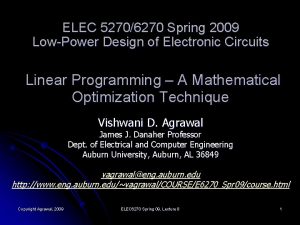ELEC 52706270 Spring 2013 LowPower Design of Electronic












































- Slides: 44

ELEC 5270/6270 Spring 2013 Low-Power Design of Electronic Circuits Memory and Multicore Design Vishwani D. Agrawal James J. Danaher Professor Dept. of Electrical and Computer Engineering Auburn University, Auburn, AL 36849 vagrawal@eng. auburn. edu http: //www. eng. auburn. edu/~vagrawal/COURSE/E 6270_Spr 13/course. html Copyright Agrawal, 2007 ELEC 6270 Spring 13, Lecture 9 1

Memory Architecture M bits SN-1 Word N-2 Word N-1 Input-Output (M bits) Copyright Agrawal, 2007 K = log 2 N N = 2 K ELEC 6270 Spring 13, Lecture 9 Word 0 Word 1 Word 2 N words A 0 A 1. AK-1 Decoder Storage cell K address lines Word 0 Word 1 Word 2 N words S 0 M bits SN-1 Storage cell Word N-2 Word N-1 Input-Output (M bits) 2

Memory Organization AL AL+1 AK– 1 Bit line Row decoder K – L bit row address 2 K – L Storage cell Word line N = 2 K M-bit words M. 2 L Sense amplifiers/drivers L bit column address A 0 AL– 1 Column decoder Input-Output (M bits) Copyright Agrawal, 2007 ELEC 6270 Spring 13, Lecture 9 3

An SRAM Cell WL VDD bit BL BL Copyright Agrawal, 2007 ELEC 6270 Spring 13, Lecture 9 4

Read Operation 1. Precharge to VDD WL 2. WL = Logic 1 VDD bit BL BL 3. Sense amplifier converts BL swing to logic level Copyright Agrawal, 2007 ELEC 6270 Spring 13, Lecture 9 5

Precharge Circuit VDD PC WL VDD Equalization device bit BL Copyright Agrawal, 2007 bit Diff. sense ampl. ELEC 6270 Spring 13, Lecture 9 BL 6

Reading 1 from Cell Pulsed to save bit line charge BL BL Precharge WL Sense ampl. output Copyright Agrawal, 2007 time ELEC 6270 Spring 13, Lecture 9 7

Write Operation, 1→ 0 2. WL = 1 WL VDD bit BL BL 1 Copyright Agrawal, 2007 1. Set BL = 0, BL = 1 ELEC 6270 Spring 13, Lecture 9 0 8

Cell Array Power Management Smaller transistors l Low supply voltage l Lower voltage swing (0. 1 V – 0. 3 V for SRAM) l l Sense amplifier restores the full voltage swing for outside use. l Power-down and sleep modes Copyright Agrawal, 2007 ELEC 6270 Spring 13, Lecture 9 9

Sense Amplifier VDD bit Full voltage swing output Sense ampl. enable: SE Low when bit lines or CLK are precharged and equalized Copyright Agrawal, 2007 ELEC 6270 Spring 13, Lecture 9 10

Sense Amplifier: Precharge VDD bit=1 ON SE=0 Copyright Agrawal, 2007 ON 0 bit=1 OFF ELEC 6270 Spring 13, Lecture 9 11

Sense Amplifier: Reading 0 VDD 0 bit=1 – ∆ OFF SE=1 Copyright Agrawal, 2007 ON 1 bit=1 ON ELEC 6270 Spring 13, Lecture 9 12

Sense Amplifier: Reading 1 VDD 1 bit=1 ON SE=1 Copyright Agrawal, 2007 OFF 0 bit=1– ∆ ON ELEC 6270 Spring 13, Lecture 9 13

Block-Oriented Architecture A single cell array may contain 64 Kbits to 256 Kbits. l Larger arrays become slow and consume more power. l Larger memories are block oriented. l Copyright Agrawal, 2007 ELEC 6270 Spring 13, Lecture 9 14

Hierarchical Organization Block 0 Block 1 Block P-1 Row addr. Column addr. Block addr. Global data bus Control circuitry Global amplifier/driver Block selector I/O Copyright Agrawal, 2007 ELEC 6270 Spring 13, Lecture 9 15

Power Saving l Block-oriented memory l Lengths of local word and bit lines are kept small. l Block address is used to activate the addressed block. l Unaddressed blocks are put in power-saving mode: sense amplifier and row/column decoders are disabled. l Cell array is put in power-saving mode. l Copyright Agrawal, 2007 ELEC 6270 Spring 13, Lecture 9 16

1. 3μ 8 -kbit SRAM 1. 1μ 900 n 0. 13μ CMOS 700 n 500 n 300 n 0. 18μ CMOS 100 n 0. 0 Copyright Agrawal, 2007 7 x increase Leakage current (Amperes) Static Power 0. 6 1. 2 1. 8 Supply voltage ELEC 6270 Spring 13, Lecture 9 17

Power Saving Modes Power-down: Disconnect supply. Data is not retained. Must be refreshed before use. Example, caches. l Increasing thresholds by body biasing: Negative bias on nonactive cells reduces leakage. l Sleep mode: l l Insert resistance in leakage path; retain data. l Lower supply voltage. Copyright Agrawal, 2007 ELEC 6270 Spring 13, Lecture 9 18

Adding Resistance in Leakage Path VDD Low-threshold transistor sleep VDD. int SRAM cell VSS. int sleep GND Copyright Agrawal, 2007 ELEC 6270 Spring 13, Lecture 9 19

Lowering Supply Voltage VDD Sleep = 1, data retention mode VDDL ≥ 100 m. V for 0. 13μ CMOS sleep SRAM cell GND Copyright Agrawal, 2007 ELEC 6270 Spring 13, Lecture 9 20

Parallelization of Memories Mem 1 Mem 2 instr. A instr. C instr. E. . . instr. B instr. D instr. F Power = C’ f/2 V 2 DD. . . f/2 f/2 0 MUX 1 C. Piguet, “Circuit and Logic Level Design, ” pp. 124 -125 in W. Nebel and J. Mermet (Eds. ), Low Power Design in Deep Submicron Electronics, Springer, 1997. Copyright Agrawal, 2007 ELEC 6270 Spring 13, Lecture 9 21

References l l l K. Itoh, VLSI Memory Chip Design, Springer. Verlag, 2001. J. M. Rabaey, A. Chandrakasan and B. Nikolić, Digital Integrated Circuits, Upper Saddle River, New Jersey: Pearson Education, Inc. , 2003, Chapter 12. S. -M. Kang and Y. Leblebici, CMOS Digital Integrated Circuits Analysis and Design, New York: Mc. Graw-Hill, 1996, Chapter 10. Copyright Agrawal, 2007 ELEC 6270 Spring 13, Lecture 9 22

Low-Power Datapath Architecture l Lower supply voltage l l l This slows down circuit speed Use parallel computing to gain the speed back Works well when threshold voltage is also lowered. About 60% reduction in power obtainable. Reference: A. P. Chandrakasan and R. W. Brodersen, Low Power Digital CMOS Design, Boston: Kluwer Academic Publishers (Now Springer), 1995. Copyright Agrawal, 2007 ELEC 6270 Spring 13, Lecture 9 23

Input Combinational logic Register A Reference Datapath Output Cref CK Supply voltage Total capacitance switched per cycle Clock frequency Power consumption: Pref Copyright Agrawal, 2007 ELEC 6270 Spring 13, Lecture 9 = Vref = Cref =f = Cref. Vref 2 f 24

Comb. Logic Copy 2 Multiphase Clock gen. and mux control f/N Register f/N N = Deg. of parallelism Register Comb. Logic Copy 1 Supply voltage: VN ≤ V 1 = Vref N to 1 multiplexer Input Register Each copy processes every Nth input, operates at f/N reduced voltage Register A Parallel Architecture Output f Comb. Logic Copy N CK Copyright Agrawal, 2007 ELEC 6270 Spring 13, Lecture 9 25

Level Converter: L to H VDDH Transistors with thicker oxide and longer channels Vout_H Vin_L VDDL N. H. E. Weste and D. Harris, CMOS VLSI Design, Third Edition, Section 12. 4. 3, Addison-Wesley, 2005. Copyright Agrawal, 2007 ELEC 6270 Spring 13, Lecture 9 26

Level Converter: H to L VDDL Vin_H Transistors with thicker oxide and longer channels Vout_L N. H. E. Weste and D. Harris, CMOS VLSI Design, Third Edition, Section 12. 4. 3, Addison-Wesley, 2005. Copyright Agrawal, 2007 ELEC 6270 Spring 13, Lecture 9 27

Control Signals, N = 4 CK Phase 1 Phase 2 Phase 3 Phase 4 Copyright Agrawal, 2007 ELEC 6270 Spring 13, Lecture 9 28

Power PN = Pproc + Poverhead Pproc = N(Cinreg+ Ccomb)VN 2 f/N + Coutreg. VN 2 f = (Cinreg+ Ccomb+Coutreg)VN 2 f = Cref. VN 2 f Poverhead = Coverhead. VN 2 f PN [1 + δ(N – 1)]Cref. VN 2 f = PN ── P 1 Copyright Agrawal, 2007 = ≈ δCref(N – 1)VN 2 f VN 2 [1 + δ(N – 1)] ─── Vref 2 ELEC 6270 Spring 13, Lecture 9 29

Voltage vs. Speed Delay of a gate, T ≈ CLVref ──── I CLVref ───── k(W/L)(Vref – Vt)2 = where I is saturation current k is a technology parameter W/L is width to length ratio of transistor Vt is threshold voltage Normalized gate delay, T 4. 0 N=2 2. 0 N=1 1. 0 0. 0 Copyright Agrawal, 2007 N=3 3. 0 1. 2μ CMOS Voltage reduction slows down as we get closer to Vt Vt V 3 V 2=2. 9 V Vref =5 V ELEC 6270 Spring 13, Lecture 9 Supply voltage 30

Increasing Multiprocessing 1. 0 1. 2μ CMOS, Vref = 5 V 0. 8 Vt=0. 8 V 0. 6 PN/P 1 Vt=0. 4 V 0. 4 0. 2 Vt=0 V (extreme case) 0. 0 1 2 3 4 5 6 7 8 9 10 11 12 N Copyright Agrawal, 2007 ELEC 6270 Spring 13, Lecture 9 31

Extreme Cases: Vt = 0 Delay, T α 1/ Vref For N processing elements, delay = NT → VN = Vref/N PN ── P 1 = [1+ δ (N – 1)] 1 ── N 2 → 1/N For negligible overhead, δ→ 0 PN ── P 1 ≈ 1 ── N 2 For Vt > 0, power reduction is less and there will be an optimum value of N. Copyright Agrawal, 2007 ELEC 6270 Spring 13, Lecture 9 32

Example: Multiplier Core l Specification: l 200 MHz Clock l 15 W dissipation @ 5 V l Low voltage operation, VDD ≥ 1. 5 volts l For threshold voltage, Vt = 0. 5 V, Clock frequency l = (VDD – 0. 5)2 ─────── GHz 20. 25 VDD Problem: l Integrate multiplier core on a SOC l Power budget for multiplier ~ 5 W Copyright Agrawal, 2007 ELEC 6270 Spring 13, Lecture 9 33

Input Multiplier Core 2 200 MHz CK Multiphase Clock gen. and mux control 40 MHz Reg 40 MHz Output Reg 40 MHz Multiplier Core 1 5 to 1 mux Reg A Multicore Design 200 MHz Multiplier Core 5 Core clock frequency = 200/N Copyright Agrawal, 2007 ELEC 6270 Spring 13, Lecture 9 34

How Many Cores? l For N cores: l clock frequency = 200/N MHz l Supply voltage, VDDN (VDDN – 0. 5)2 = 4. 05 VDDN/N VDDN 2 – (1+4. 05/N) VDDN + 0. 25 = 0 l Assuming 10% overhead per core, VDDN 2 Power dissipation =15 [1 + 0. 1(N – 1)] (───) watts 5 Copyright Agrawal, 2007 ELEC 6270 Spring 13, Lecture 9 35

Design Tradeoffs Clock (MHz) Core supply VDDN (volts) Total Power (watts) 1 200 5. 00 15. 0 2 100 2. 94 5. 70 3 66. 67 2. 24 3. 61 4 50 1. 88 2. 76 5 40 1. 66 2. 32 Number of cores, N Copyright Agrawal, 2007 ELEC 6270 Spring 13, Lecture 9 36

Power Reduction in Processors l l Just about everything is used. Hardware methods: Voltage reduction for dynamic power l Dual-threshold devices for leakage reduction l Clock gating, frequency reduction l Sleep mode l l Architecture: Instruction set l hardware organization l l Software methods Copyright Agrawal, 2007 ELEC 6270 Spring 13, Lecture 9 37

Parallel Architecture Processor Input Processor Output f/2 Input f Processor Capacitance = C Voltage = V Frequency = f Power = CV 2 f f/2 Copyright Agrawal, 2007 ELEC 6270 Spring 13, Lecture 9 f Capacitance = 2. 2 C Voltage = 0. 6 V Frequency = 0. 5 f Power = 0. 396 CV 2 f 38

Output Input ½ Proc. Register Processor Register Input Register Pipeline Architecture ½ Proc. Output f f Capacitance = 1. 2 C Voltage = 0. 6 V Frequency = f Power = 0. 432 CV 2 f Capacitance = C Voltage = V Frequency = f Power = CV 2 f Copyright Agrawal, 2007 ELEC 6270 Spring 13, Lecture 9 39

Approximate Trend n-parallel proc. n-stage pipeline proc. Capacitance n. C C Voltage V/n Frequency f/n f Power CV 2 f/n 2 Chip area n times 10 -20% increase G. K. Yeap, Practical Low Power Digital VLSI Design, Boston: Springer, 1998. Copyright Agrawal, 2007 ELEC 6270 Spring 13, Lecture 9 40

Performance based on SPECint 2000 and SPECfp 2000 benchmarks Multicore Processors Copyright Agrawal, 2007 Computer, May 2005, p. 12 Multicore Single core 2000 2004 ELEC 6270 Spring 13, Lecture 9 2008 41

Multicore Processors l l l D. Geer, “Chip Makers Turn to Multicore Processors, ” Computer, vol. 38, no. 5, pp. 11 -13, May 2005. A. Jerraya, H. Tenhunen and W. Wolf, “Multiprocessor Systems-on-Chips, ” Computer, vol. 5, no. 7, pp. 36 -40, July 2005; this special issue contains three more articles on multicore processors. S. K. Moore, “Winner Multimedia Monster – Cell’s Nine Processors Make It a Supercomputer on a Chip, ” IEEE Spectrum, vol. 43. no. 1, pp. 20 -23, January 2006. Copyright Agrawal, 2007 ELEC 6270 Spring 13, Lecture 9 42

Cell - Cell Broadband Engine Architecture © IEEE Spectrum, January 2006 Nine-processor chip: 192 Gflops Copyright Agrawal, 2007 L to R Atsushi Kameyama, Toshiba James Kahle, IBM Masakazu Suzoki, Sony ELEC 6270 Spring 13, Lecture 9 43

Cell’s Nine-Processor Chip © IEEE Spectrum, January 2006 Copyright Agrawal, 2007 ELEC 6270 Spring 13, Lecture 9 Eight Identical Processors f = 5. 6 GHz (max) 44. 8 Gflops 44
 Elec 4601
Elec 4601 Elec 4601
Elec 4601 Keesmel
Keesmel Picture recognition
Picture recognition Elec
Elec Elec
Elec Saif zahir
Saif zahir Elec 202
Elec 202 Spring summer fall winter and spring cast
Spring summer fall winter and spring cast Spring summer autumn winter
Spring summer autumn winter An electronic is the electronic exchange of money or scrip
An electronic is the electronic exchange of money or scrip Electronic news gathering and electronic field production
Electronic news gathering and electronic field production Ist spring design
Ist spring design Ist spring design
Ist spring design Cs 612
Cs 612 Esl design
Esl design Electronic system level design
Electronic system level design Ytv 2012
Ytv 2012 Lembar pengesahan dokumen 1 kurikulum 2013
Lembar pengesahan dokumen 1 kurikulum 2013 Microsoft access tutorial 2013
Microsoft access tutorial 2013 Quran in word 2013
Quran in word 2013 Brs 2013
Brs 2013 Apes frq 2013
Apes frq 2013 Iso 690:2013
Iso 690:2013 Legge 107 del 2015
Legge 107 del 2015 Siakad 2013 uny
Siakad 2013 uny Rpp menulis permulaan
Rpp menulis permulaan Fiscal incentives for industrial promotion (revised)-2013
Fiscal incentives for industrial promotion (revised)-2013 Pmi 2013
Pmi 2013 Gred spm 2020
Gred spm 2020 Plan nacional del buen vivir 2009 al 2013
Plan nacional del buen vivir 2009 al 2013 Ilc 2013
Ilc 2013 Cakupan penilaian
Cakupan penilaian Owasp top ten 2013
Owasp top ten 2013 Owasp top 10 2013
Owasp top 10 2013 Saresp 2013 o edificio da foto abaixo
Saresp 2013 o edificio da foto abaixo Organigramme sante
Organigramme sante Mendeley literaturverzeichnis erstellen
Mendeley literaturverzeichnis erstellen Lync 2013 features
Lync 2013 features C.m. n. 8 del 6 marzo 2013 sintesi
C.m. n. 8 del 6 marzo 2013 sintesi Ley 1620 de 2013 doc
Ley 1620 de 2013 doc Dpr 80 2013 sintesi
Dpr 80 2013 sintesi Dpr 80 2013 fasi
Dpr 80 2013 fasi Perumusan ipk kurikulum 2013 berorientasi abad 21
Perumusan ipk kurikulum 2013 berorientasi abad 21 Tempoh pelawaan sebutharga
Tempoh pelawaan sebutharga
